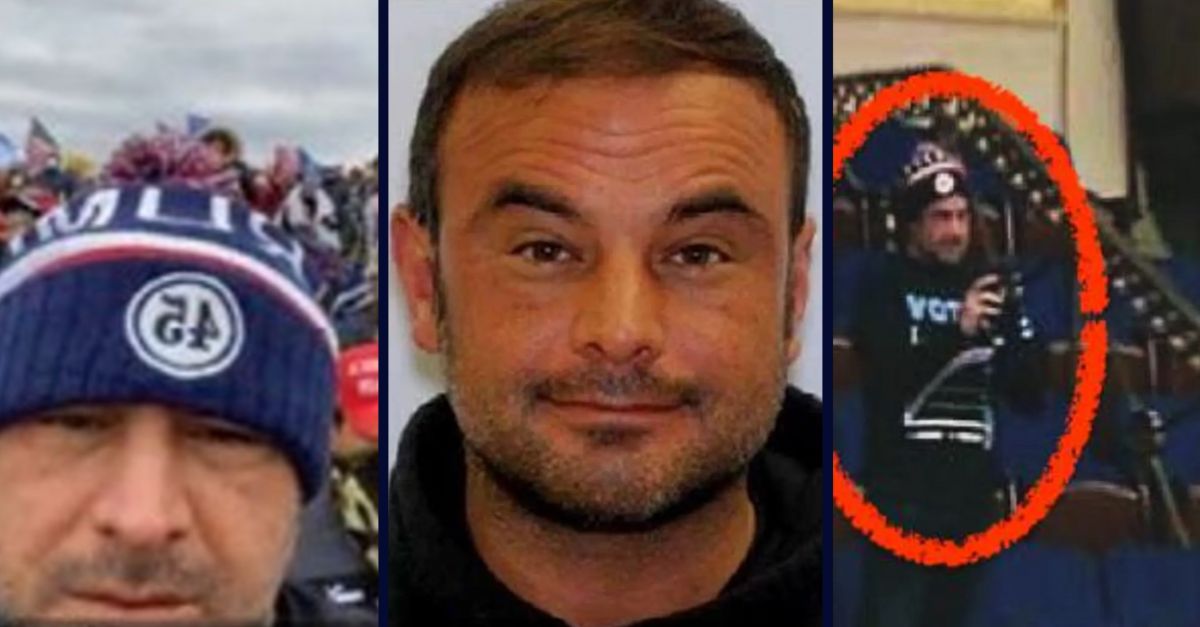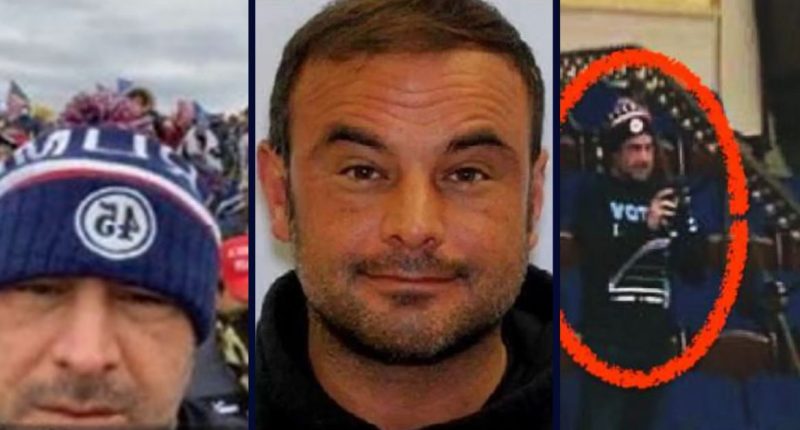
Left inset: An alleged selfie of Elias Costianes at the U.S. Capitol during the Jan. 6 attack (Justice Department). Center inset: Elias Costianes (Justice Department). Right inset: An alleged photo of Elias Costianes inside the U.S. Capitol during the Jan. 6 attack (Justice Department).
A federal judge in Baltimore is forcing the government and a Jan. 6 defendant to work a little harder before applying President Donald Trump‘s mass pardon to an attenuated gun crimes case.
In a Thursday memorandum and order, U.S. District Judge James Kelleher Bredar, a Barack Obama appointee, repeatedly dismissed the idea that his court would be a “rubber stamp” for the government.
In February 2021, the defendant, Elias Costianes, was brought up on firearms charges following the execution of warrants by federal agents investigating the Jan. 6 riots at the U.S. Capitol Complex. At roughly the same time, federal prosecutors also brought a formally separate case, directly based on allegations that Costianes joined the pro-Trump mob at the Capitol and filmed himself inside the building.
In September 2023, Costianes pleaded guilty to one count of possession of firearms and ammunition by an unlawful user of any controlled substance. He was subsequently sentenced to serve 24 months in prison, followed by two years of supervised release.
Meanwhile, the defendant’s Jan. 6 case lingered — and was still stuck in the maw of the federal legal system when the 45th and 47th president issued blanket pardons to all Jan. 6 defendants on Jan. 20.
In February, on the same day he reported to prison, Costianes filed motions with the 4th Circuit Court of Appeals to have his sentence enjoined, stayed and overturned — based on Trump’s blanket pardon.
A bit of a procedural punting mess ensued: the defendant’s pre-pardon appeal was effectively abandoned; then the 4th Circuit asked the defendant and the government to answer specific questions; instead the parties filed a joint motion to vacate the sentence; that motion was followed by an appellate court order and additional briefing; and then came a remand back down to the district court.
At the same time, lawyers were busy at the district court level. A motion to vacate was tersely denied by Bredar in early March. Then, a motion for release from custody and to stay the sentence pending appeal was volubly nixed by the lower court in late March.
“He does not explain why it is likely that his conviction will be vacated on appeal,” the judge wrote — annoyed at the nature of arguments essayed. “Indeed, it is not entirely clear on what basis he even seeks a vacatur of his sentence on appeal, given that the currently pending joint motion before the Fourth Circuit simply asks the Fourth Circuit ‘to vacate the defendant’s conviction’ but does not provide a basis for doing so. And, although it cites the pardon, the parties explicitly did not respond to the Fourth Circuit’s questions regarding the pardon.”
More Law&Crime coverage: ‘Entitled to reimbursement’: Trump DOJ says Jan. 6 defendants deserve to get restitution refunds after having cases ‘invalidated’
Now, after all of the procedural back-and-forth, which was really an attempt for parallel relief by whichever court possible, the ball is firmly back in Bredar’s hands. And, the judge is telling the DOJ and Costianes they must be more than conclusory moving forward.
“With respect to whether the January 20 Pardon applies to Costianes’ conviction, neither party has provided this Court with any briefing on the question,” the judge wrote in the latest order. “Given the Fourth Circuit’s directive that this Court consider the impact of the January 20 Pardon on Costianes’ conviction, this is a question the Court must take up.”
In other words, the judge says that in all the months of court documents filed, neither Costianes nor the DOJ had actually argued why Trump’s blanket pardon applies to the gun case, instead relying on the bare assertion that the pardon does apply, no questions asked.
But Bredar writes that there is a “substantial question” to ask.
“The parties will be directed to provide additional briefing,” the order goes on. “[T]he Court concludes for purposes of this remand that such Motion raises a substantial question.”
The government used a so-called “Rule 48 Motion” to force the issue in the present case. Under this federal Rule of Criminal Procedure, which governs dismissal of cases, a court has very limited discretion whether or not to grant the government’s dismissal request.
But there is some discretion.
“[T]he Court must not simply act as a rubber stamp in this context, which would render the ‘leave of court’ requirement in Rule 48 superfluous,” Bredar writes in his Thursday order.
At least three judges have dismissed pending cases for Jan. 6 defendants, including Guy Reffitt, an alleged rioter accused of carrying a gun into the Capitol who was later caught with an illegal silencer in Texas. The DOJ, in a stark reversal, has also started voicing its approval of such dismissals in recent weeks and months, saying it agrees that Trump’s mass pardon covers “related” crimes in at least seven cases across the country, according to The Washington Post.
Several judges have rejected efforts for Jan. 6 defendants to have other criminal cases tossed, but the results have been inconsistent, as has the government’s own attitude toward such cases, the judge noted in the Thursday order.
“[T]he Court understands the Government’s basis for the Rule 48 Motion to be its interpretation of the January 20 Pardon and its conclusion that it applies to Costianes, regardless of whether this Court (or an appellate court) agrees that such conclusion is legally correct,” Bredar’s order continues. “However, the Government has taken inconsistent positions with respect to the January 20 Pardon. While the Government has taken the position that it has in this case in other cases it has also taken the position that the Pardon does not apply to others.”
Love true crime? Sign up for our newsletter, The Law&Crime Docket, to get the latest real-life crime stories delivered right to your inbox.
The government’s varying positions, laid out with a few examples in the court’s order, have clearly made the judge suspicious.
More important, the court, citing precedent, noted that “misleading and inconsistent assertions sometimes reveal bad faith.” The judge suggested a determination of bad faith might trigger his limited power to reject the government’s request under Rule 48.
But, Bredar suggested he could be convinced otherwise, cautioning DOJ lawyers to step up their legal analysis as the case continues.
The court’s order offers both leeway and a warning, at length:
Perhaps there is some good faith reason for these seemingly inconsistent positions. And perhaps taking such inconsistent positions does not rise to the level of ‘bad faith’ meriting denial of a Rule 48 motion. Further, to the extent that this Court rules that the January 20 Pardon does not apply to Costianes’ conviction, it is not clear whether the Government’s differing interpretation of the Pardon could form the basis of a Rule 48 motion. As noted above, the Court cannot simply act as a rubber stamp, and although the Court’s discretion is tightly limited in this context-the “leave of court” requirement in Rule 48(a) provides the Court with “a discretion broad enough to protect the public interest in the fair administration of criminal justice.”
Chris Perez contributed to this report.








